When he was 19 years old, Riccardo Arena left for Burkina Faso, without a return ticket and the desire to travel. Precisely to this experience I think the origin of his artistic practice of the last years should be traced back. The genesis of his works is given by long periods of research combined with repeated trips to different countries of the world. From China for the Quattro volte albero in 2006, Argentina and Bolivia for Double Death. Eller and visual ecosystem in 2009, up to the Solovki Islands in the Russian White Sea in 2013, an archipelago 160 km away from the Arctic Circle that favored the birth of VAVILON, the last work of the artist. With a specific focus on these three projects, the following interview frames Arena’s research in relation to the themes of the trip and the archive.
You told me about the artistic process – the journey, in your case – as a personal cognitive tool. Could you elaborate on this affirmation in relation to the three projects carried out in China, Latin America and the Solovki Islands?
Over the years I have dedicated many of my energies in playing the role of what I ironically call “worker of images.” Through comics, animation, video productions, art direction and ceramics, I have transited in very much different situations and environments, collaborating with working groups such as Vumeter, Sun-Wu Kung, Box and Atrium-Project. All these experiences allowed me to meet exceptional people, who have deeply enriched me.
During this period, however, I gradually felt the need to reappropriate a more meditative dimension of “doing”, paying more attention to the processes involved in the development of visual and narrative poetics. My aspiration was to use these processes as “cognitive tools”: sources of surprise, valorization and personal amazement, where the attention turns from the production of “images” to the creation of “imaginary”, in which the formalization becomes a consequence of a path centered mainly on the discovery, a need stimulated also by the historical period with which I find myself interacting and whose visual bulimia, with relative excess of perception, made me feel the weight of a production and consumption with little nourishment, not only as a user, but above all as an architect.
To this end, in parallel with other activities, I have dedicated myself to the formulation of independent projects in different countries of the world characterized by dilated processing times, whose contents are manifested and developed through the warp of researches and experiences that arise during the trip … a journey that however I continue to consider ageographic in spite of the fact that the physiognomic characters of each project are modeled by the cultural landscapes that I visit.
Despite the wide “domino of possibilities” offered by circumstances, there are topics and situations that more than others magnetize my attention. Looking at the evolution of projects after 10 years, I can not help but notice a red thread, a tension that unites them: the Chinese project that describes a dystopian future celebrating the traces of a vanished civilization, the Argentine one that tells a metaphysical investigation devoted to the oblivion of identity and the Russian one where the desperate escape from the labyrinth of mortality is told, through Soviet aerospace research.
Between 2006 and 2008 you travel to China for Il quattro volte albero, a project that is formalized in a complex set of images that tell a world in which reality merges with fantastic and apocalyptic visions. The starting point is an interest in the natural world: the landscape, the garden and their life cycle. Tracts, bringing to the extreme, a research that links the theme of natural growth to urban growth – also increasingly uncontrolled. Central to this work are the concepts of destruction, catastrophe and regeneration. I would like to understand the link of these reflections with the Chinese territory: why this title and what urgency did you want to answer with this work?
When I was living in London, a dear friend of mine, Piccia Neri, asked me to accompany her to Shanghai where she was invited to write a catalog for the British Art Council coordinated by Simon Kirby, a figure that proved to be fundamental for the development of my work.
During one of the first walks on the Huang Pu River I remember I was hypnotized by the long barges that went up and down the river at dawn; through an optical game, the building materials carried by the boats gave the impression of forming landscapes in perpetual creation and dissolution. Two years later that vision would have suggested video 25.765, the motive of the whole work. The title Il Quattro volte albero is inspired by the character “MU”, the first trace of an ideographic view linked to the concept of garden, found on some Chinese drums dating back to the fifteenth century BC, whose meaning is precisely of garden or park, microcosmic reiteration of the Universe in which reside the mythological forces which retain of the technical and evolutionary progress of the terrestrial civilization.
Stimulated by the practice of the architect of the Chinese garden, who abandons the preconceived project in favor of a contemplation of the natural elements offered to him by the surrounding environment, Il Quattro volte albero is the result of multiple trips to China. The suggestions and heterogeneous elements of each journey have accumulated, overlapped and mixed, actively participating in the definition of a utopian nature reserve that unites and fuses the manifestation of an evolved and vanished society, whose presence is celebrated in a distant and mythical future, through the harmonization of its remains.
From the examination of the natural theme developed in this project you move towards the subjectivity of the ego. In 2009 you are in Argentina for Double Death. Ellero and visual ecosystem. What brings you here to develop this work and to deepen the themes of identity, individuation and identity? Write that “the logic of the story is structured through the archive paradigm”. What does it mean?
The origin of this second project is linked to the theft of a camera that was stolen by a fake monk while I was visiting a village in Sichuan, China. After several vicissitudes the adventure ended a week later with the discovery of the monk and, at the time of the recovery of the camera, I was asked to sign a document with my fingerprint. That image struck me in such a way as to push me later to document the origins of the history of identification, since the tribal man was forced out of his community to belong to show the “other” his identity: “who was”. A story that, moving from divination practices, touches phrenology, biological determinism, statistical science applied to photographic archives, anthropometry, dactyloscopy, graphology and biometrics. The various researches allowed me to discover that the first catalog of fingerprints was completed in 1892 by a police inspector from La Plata in Argentina, Juan Vucetich, father of fingerprinting. The trip to Buenos Aires in 2009 would thus be transformed into a four and a half year stay and the project had a long gestation. In the months I had accumulated a lot of material that floated in the diaries without finding organicity or meaning until, during a stay in a village between Bolivia and Peru inhabited by a community of Curanderos _nomadi, the Kallawaya, I was told of the Lugar Kuna. Lugar Kuna are sacred places, worthy for the celebration of the deity, identified by the traces left by lightning on the ground after the storms. For a moment that information had the power to circulate all previous research, crystallizing into a story that would provide the basis for the development of the works of the project Double Death Eller and visual ecosystem. This paper tells the investigation of a detective whose goal is the reconstruction of the identity of a person who took his life using a complex mechanism of death inspired by the “Twin Ellero”, a shooting system used in the signage photography of the first of the twentieth century and designed by Umberto Ellero. This type of framing allowed to take the face from two different angles using two cameras placed at 90 ° whose shutters were operated simultaneously by a pneumatic system to avoid possible alterations in facial expressions. cameras with two guns to collide the bullets at a precise point of the head, with the consequent dissolution of the face and the appearance of a figure of Lichtenberg on his body: an electric abrasion that in some cases appears on people affected by lightning. The complex investigation processes will lead the detective to consider suicide as a ritual and symbolic map, in which the boundary between observer and observed is sublimated through an absolute resemblance that equals equality, non-existent in nature, as two things can never be equal in every respect and yet remain two.
To answer your question regarding the “archive paradigm” I could not find a better definition than the one given by the American photographer Allan Sekula “… a vast substitutive system that establishes a relationship of general equivalence between the images. The camera opened the way to a truth that could be expressed in the abstract universal language of mathematics, promising to reduce nature to its geometric essence “.
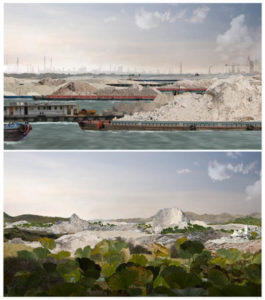 Riccardo Arena, Il quattro volte albero – 25.765 – video stills, dur. 7 min., 2008
Riccardo Arena, Il quattro volte albero – 25.765 – video stills, dur. 7 min., 2008
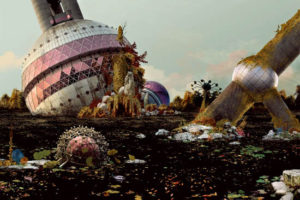 Riccardo Arena, Il quattro volte albero – E gli Dei si rannicchiarono al muro come cani randagi, Lambda print, 110 x 165 cm, 2008
Riccardo Arena, Il quattro volte albero – E gli Dei si rannicchiarono al muro come cani randagi, Lambda print, 110 x 165 cm, 2008
 Riccardo Arena, Duplice morte Ellero ed ecosistema visivo – Exhibition view (detail), Long Play, MAGA, photo by Roberto Marossi, 2012
Riccardo Arena, Duplice morte Ellero ed ecosistema visivo – Exhibition view (detail), Long Play, MAGA, photo by Roberto Marossi, 2012
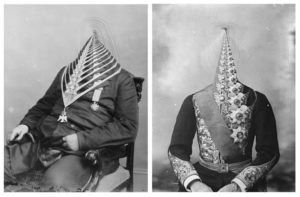 Riccardo Arena, Duplice morte Ellero ed ecosistema visivo – Lichtloch # 2-3, 2012
Riccardo Arena, Duplice morte Ellero ed ecosistema visivo – Lichtloch # 2-3, 2012
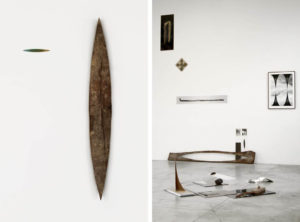 Riccardo Arena, Vavilon – Exhibition View – Viafarini, 2015
Riccardo Arena, Vavilon – Exhibition View – Viafarini, 2015
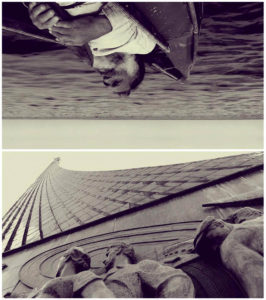 Riccardo Arena, Vavilon – Video stills, dur. 26 min., 2015
Riccardo Arena, Vavilon – Video stills, dur. 26 min., 2015
In general your work, given by a stratification of time – long – and spaces that you physically cross, takes the form of an archive of fragments, an intimate and personal diary that reveals itself step by step to the viewer. Archiving allows you to sort your existing and your experience in a given place. It intrigues me to know more about the process of accumulation of the material and the consequent exclusion of what you consider unnecessary for the exhibition.
The use of the archive is subordinated mainly to the embryonic phases of the work. I am not very interested in the practice of study or cataloging as an end in itself, my interest is rather on the observation of the correspondences generated by the association of materials entered into mutual contact. Satellites that, gravitating on different orbits, generate configurations, alignments and unexpected visions that, once contemplated, give rise to new keys of reading, losing their autonomy and placing me in a position of spectator. I could not therefore define it as a process of choice and waste, but rather as a suggestive texture between the parts. The continuous movement between the collection of study materials, the travel experiences and their internal transfiguration is condensed into narrative structures that act as guidelines for the development of “compositional pictures” made up of works that together tell aspects of the poetic sub-frame that coagulates the general mink.
The result of each project exhibited is thus the result of a structured process that combines randomness with suggestion, intentionality with unpredictability, and you told me that your projects come from precise spatio-temporal coincidences. For example, it was while you were in Buenos Aires that your interest in the Solovki islands was born. What was the event or the meeting that led you to move from one hemisphere to another? How was your interest in these islands born?
Visiting Solovki in 2013 was the result of the profound respect and interest I have had for many years for the life and thought of Pavel Florensky, a Russian philosopher, mystic, critic and scientist who, like hundreds of intellectuals of his time, died in 1929 in the correction camp established on the islands, first large-scale detention experiment. The first documentation on the archipelago of the White Sea made me discover a real Pandora’s box until then unknown: this enigmatic fragment of land emerged, a few kilometers from the Arctic Circle, over the millennia was the catalyst of a series of events that have changed the history of the Continent. “Today at Solovki, tomorrow in Russia” says a Russian proverb.
You told me about the VAVILON | exhibition Project C – Solovki Island in Viafarini as “a rarefied space, a box that opens up to the visitor able to create a kaleidoscope of images and continuous references”. The exhibition contains a series of visual notes – drawings, photographs, collages, videos, objects – of various sizes and uniformly placed in space, from the floor to the walls. What do these devices tell and how do they relate to the video presented at the Sandretto Re Rebaudengo Foundation?
VAVILON starts from the study of the history of this poignant archipelago in the extreme north of Russia. For thousands of years it has been considered sacred, as evidenced by the countless traces left by the early White Sea cultures including 35 labyrinths, the largest in the world, now guarded by a community of Orthodox ascetic monks, and a spiritual destination for pilgrimages. After the Bolshevik revolution, this imposing monastic complex, developed on the islands since the 15th century and linked to the history of three Russian monks, has been converted into administrative headquarters for the creation of the special regime of the Solovki (SLON), a prototype of terror engineering which would later be transformed into the GULAG system.
Thanks to the documentation on the labyrinths of the Solovki, I came into contact with the fascinating and fascinating theories of the engineer Marco Bulloni who made a great contribution to the visions of the project and the organization of the stay on the islands in 2013. A stay that later, would have led me to the meeting with the “cosmism”, a current of philosophical-scientific thought born from the conceptions of Nikolai Fyodorov who, in the mid 800’s, proposed as objective the conquest of immortality and resurrection through the common work of the human race. This movement was joined by the most important Russian personalities of the twentieth century and, subsequently, it would have contributed to the development of the Soviet aerospace program, weaving a hidden subplot in the first Bolshevism.
The poetics of the project is therefore based on the cartographic transfiguration of the island as a representation of the human condition whose effort is aimed at transcending death through a mystical-scientific escape from the labyrinth of worldly sufferings whose entry is placed in a horizontal and terrestrial dimension and the output in a vertical and celestial dimension. An escape that targets the higher regions of the soul and the cosmos, through planetary colonization, and which has, as a key image of its failure, the Tsiolkovsky crater on the dark side of the moon. The crater was photographed for the first time by the satellite Moon 3 in 1959 and is baptized with the name of the father of Russian cosmonautics. The figure of the cosmist Konstantin Tsiolkovsky also starred in the video work, shot between the Solovki and Stromboli, presented in Turin at the Sandretto Foundation for the exhibition “The man who sat on himself” in September 2015 in conjunction with the solo show in Milan in Viafarini where I presented the entire visual compendium of VAVILON accompanied by two days of conferences attended by Marco Bulloni, Giorgio Galli, Gian Piero Piretto, Matteo Bertelé, Matteo Guarnaccia and Massimiliano Judica Cordiglia.
In which part of the world are you now? Are you planning a new trip and a new project?
At the moment I am shuttling between Milan and Prague. As for future projects in this period I’m dedicating to a book on VAVILON, meditating on my contribution to the exhibition at MAXXI and planning a trip to Iran linked to some suggestions … but more than I could not tell you.
Michela Lupieri (* 1983) is curator, researcher and author. She graduated at IUAV of Venice in Visual Arts, with a specialization in contemporary art and curatorial practices. She is part of the curatorial team of Palinsesti and research fellow at the Archive of the Avant-gardes (Collezione Marzona) at the SKD of Dresden. She lives between Italy and Germany.


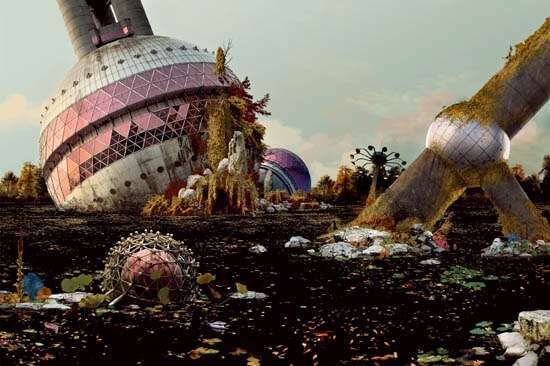




NO COMMENT